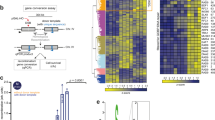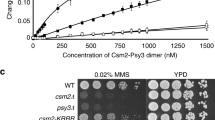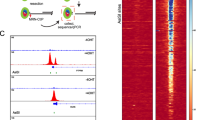Abstract
The repair of DNA double-strand breaks (DSBs) by homologous recombination is essential for genomic stability. The first step in this process is resection of 5′ strands to generate 3′ single-stranded DNA intermediates. Efficient resection in budding yeast requires the Mre11–Rad50–Xrs2 (MRX) complex and the Sae2 protein, although the role of MRX has been unclear because Mre11 paradoxically has 3′→5′ exonuclease activity in vitro. Here we reconstitute resection with purified MRX, Sae2 and Exo1 proteins and show that degradation of the 5′ strand is catalyzed by Exo1 yet completely dependent on MRX and Sae2 when Exo1 levels are limiting. This stimulation is mainly caused by cooperative binding of DNA substrates by Exo1, MRX and Sae2. This work establishes the direct role of MRX and Sae2 in promoting the resection of 5′ strands in DNA DSB repair.
This is a preview of subscription content, access via your institution
Access options
Subscribe to this journal
Receive 12 print issues and online access
$189.00 per year
only $15.75 per issue
Buy this article
- Purchase on Springer Link
- Instant access to full article PDF
Prices may be subject to local taxes which are calculated during checkout







Similar content being viewed by others
References
San Filippo, J., Sung, P. & Klein, H. Mechanism of eukaryotic homologous recombination. Annu. Rev. Biochem. 77, 229–257 (2008).
Aylon, Y., Liefshitz, B. & Kupiec, M. The CDK regulates repair of double-strand breaks by homologous recombination during the cell cycle. EMBO J. 23, 4868–4875 (2004).
Ira, G. et al. DNA end resection, homologous recombination and DNA damage checkpoint activation require CDK1. Nature 431, 1011–1017 (2004).
Wyman, C. & Kanaar, R. DNA double-strand break repair: all's well that ends well. Annu. Rev. Genet. 40, 363–383 (2006).
Krogh, B.O. & Symington, L.S. Recombination proteins in yeast. Annu. Rev. Genet. 38, 233–271 (2004).
Vaze, M.B. et al. Recovery from checkpoint-mediated arrest after repair of a double-strand break requires Srs2 helicase. Mol. Cell 10, 373–385 (2002).
Fishman-Lobell, J., Rudin, N. & Haber, J.E. Two alternative pathways of double-strand break repair that are kinetically separable and independently modulated. Mol. Cell. Biol. 12, 1292–1303 (1992).
Zierhut, C. & Diffley, J.F. Break dosage, cell cycle stage and DNA replication influence DNA double strand break response. EMBO J. 27, 1875–1885 (2008).
Chung, W.H., Zhu, Z., Papusha, A., Malkova, A. & Ira, G. Defective resection at DNA double-strand breaks leads to de novo telomere formation and enhances gene targeting. PLoS Genet. 6, e1000948 (2010).
Barlow, J.H., Lisby, M. & Rothstein, R. Differential regulation of the cellular response to DNA double-strand breaks in G1. Mol. Cell 30, 73–85 (2008).
Alani, E., Padmore, R. & Kleckner, N. Analysis of wild-type and rad50 mutants of yeast suggests an intimate relationship between meiotic chromosome synapsis and recombination. Cell 61, 419–436 (1990).
Nairz, K. & Klein, F. mre11S—a yeast mutation that blocks double-strand-break processing and permits nonhomologous synapsis in meiosis. Genes Dev. 11, 2272–2290 (1997).
Tsubouchi, H. & Ogawa, H. A novel mre11 mutation impairs processing of double-strand breaks of DNA during both mitosis and meiosis. Mol. Cell. Biol. 18, 260–268 (1998).
Ivanov, E.L., Sugawara, N., White, C.I., Fabre, F. & Haber, J.E. Mutations in XRS2 and RAD50 delay but do not prevent mating-type switching in Saccharomyces cerevisiae. Mol. Cell. Biol. 14, 3414–3425 (1994).
Clerici, M., Mantiero, D., Lucchini, G. & Longhese, M.P. The Saccharomyces cerevisiae Sae2 protein promotes resection and bridging of double strand break ends. J. Biol. Chem. 280, 38631–38638 (2005).
Paull, T.T. & Gellert, M. The 3′ to 5′ exonuclease activity of Mre 11 facilitates repair of DNA double-strand breaks. Mol. Cell 1, 969–979 (1998).
Connelly, J.C., de Leau, E.S. & Leach, D.R.F. DNA cleavage and degradation by the SbcCD protein complex from Escherichia coli. Nucleic Acids Res. 27, 1039–1046 (1999).
Trujillo, K.M. & Sung, P. DNA structure-specific nuclease activities in the Saccharomyces cerevisiae Rad50–Mre11 complex. J. Biol. Chem. 276, 35458–35464 (2001).
Hopfner, K.P. et al. Mre11 and Rad50 from Pyrococcus furiosus: cloning and biochemical characterization reveal an evolutionarily conserved multiprotein machine. J. Bacteriol. 182, 6036–6041 (2000).
Moreau, S., Ferguson, J.R. & Symington, L.S. The nuclease activity of Mre11 is required for meiosis but not for mating type switching, end joining, or telomere maintenance. Mol. Cell. Biol. 19, 556–566 (1999).
Llorente, B. & Symington, L.S. The Mre11 nuclease is not required for 5′ to 3′ resection at multiple HO-induced double-strand breaks. Mol. Cell. Biol. 24, 9682–9694 (2004).
Usui, T. et al. Complex formation and functional versatility of Mre11 of budding yeast in recombination. Cell 95, 705–716 (1998).
Mimitou, E.P. & Symington, L.S. Sae2, Exo1 and Sgs1 collaborate in DNA double-strand break processing. Nature 455, 770–774 (2008).
Zhu, Z., Chung, W.H., Shim, E.Y., Lee, S.E. & Ira, G. Sgs1 helicase and two nucleases Dna2 and Exo1 resect DNA double-strand break ends. Cell 134, 981–994 (2008).
Budd, M.E. & Campbell, J.L. Interplay of Mre11 nuclease with Dna2 plus Sgs1 in Rad51-dependent recombinational repair. PLoS ONE 4, e4267 (2009).
Hopkins, B.B. & Paull, T.T. The P. furiosus Mre11/Rad50 complex promotes 5′ strand resection at a DNA double-strand break. Cell 135, 250–260 (2008).
Lengsfeld, B.M., Rattray, A.J., Bhaskara, V., Ghirlando, R. & Paull, T.T. Sae2 is an endonuclease that processes hairpin DNA cooperatively with the Mre11/Rad50/Xrs2 complex. Mol. Cell 28, 638–651 (2007).
Tran, P.T., Erdeniz, N., Dudley, S. & Liskay, R.M. Characterization of nuclease-dependent functions of Exo1p in Saccharomyces cerevisiae. DNA Repair (Amst.) 1, 895–912 (2002).
Trujillo, K.M., Yuan, S.S., Lee, E.Y. & Sung, P. Nuclease activities in a complex of human recombination and DNA repair factors Rad50, Mre11, and p95. J. Biol. Chem. 273, 21447–21450 (1998).
Yang, S.W. & Nash, H.A. Specific photocrosslinking of DNA-protein complexes: identification of contacts between integration host factor and its target DNA. Proc. Natl. Acad. Sci. USA 91, 12183–12187 (1994).
Thomas, K.R. & Olivera, B.M. Processivity of DNA exonucleases. J. Biol. Chem. 253, 424–429 (1978).
Niu, H. et al. Mechanism of the ATP-dependent DNA end-resection machinery from Saccharomyces cerevisiae. Nature 467, 108–111 (2010).
Cejka, P. et al. DNA end resection by Dna2-Sgs1-RPA and its stimulation by Top3-Rmi1 and Mre11-Rad50-Xrs2. Nature 467, 112–116 (2010).
Chamankhah, M., Fontanie, T. & Xiao, W. The Saccharomyces cerevisiae mre11(ts) allele confers a separation of DNA repair and telomere maintenance functions. Genetics 155, 569–576 (2000).
Moreau, S., Morgan, E.A. & Symington, L.S. Overlapping functions of the Saccharomyces cerevisiae Mre11, Exo1 and Rad27 nucleases in DNA metabolism. Genetics 159, 1423–1433 (2001).
Lewis, L.K., Karthikeyan, G., Westmoreland, J.W. & Resnick, M.A. Differential suppression of DNA repair deficiencies of yeast rad50, mre11 and xrs2 mutants by EXO1 and TLC1 (the RNA component of telomerase). Genetics 160, 49–62 (2002).
Lee, S.E., Bressan, D.A., Petrini, J.H. & Haber, J.E. Complementation between N-terminal Saccharomyces cerevisiae mre11 alleles in DNA repair and telomere length maintenance. DNA Repair (Amst.) 1, 27–40 (2002).
Paull, T.T. & Gellert, M. Nbs1 potentiates ATP-driven DNA unwinding and endonuclease cleavage by the Mre11/Rad50 complex. Genes Dev. 13, 1276–1288 (1999).
Lee, J.H. & Paull, T.T. ATM activation by DNA double-strand breaks through the Mre11–Rad50–Nbs1 complex. Science 308, 551–554 (2005).
Nimonkar, A.V., Ozsoy, A.Z., Genschel, J., Modrich, P. & Kowalczykowski, S.C. Human exonuclease 1 and BLM helicase interact to resect DNA and initiate DNA repair. Proc. Natl. Acad. Sci. USA 105, 16906–16911 (2008).
Milman, N., Higuchi, E. & Smith, G.R. Meiotic DNA double-strand break repair requires two nucleases, MRN and Ctp1, to produce a single size class of Rec12 (Spo11)-oligonucleotide complexes. Mol. Cell. Biol. 29, 5998–6005 (2009).
Hartsuiker, E. et al. Ctp1CtIP and Rad32Mre11 nuclease activity are required for Rec12Spo11 removal, but Rec12Spo11 removal is dispensable for other MRN-dependent meiotic functions. Mol. Cell. Biol. 29, 1671–1681 (2009).
Rothenberg, M., Kohli, J. & Ludin, K. Ctp1 and the MRN-complex are required for endonucleolytic Rec12 removal with release of a single class of oligonucleotides in fission yeast. PLoS Genet. 5, e1000722 (2009).
Hartsuiker, E., Neale, M.J. & Carr, A.M. Distinct requirements for the Rad32(Mre11) nuclease and Ctp1(CtIP) in the removal of covalently bound topoisomerase I and II from DNA. Mol. Cell 33, 117–123 (2009).
Buis, J. et al. Mre11 nuclease activity has essential roles in DNA repair and genomic stability distinct from ATM activation. Cell 135, 85–96 (2008).
Lisby, M., Barlow, J.H., Burgess, R.C. & Rothstein, R. Choreography of the DNA damage response: spatiotemporal relationships among checkpoint and repair proteins. Cell 118, 699–713 (2004).
Lee, K., Zhang, Y. & Lee, S.E. Saccharomyces cerevisiae ATM ortholog suppresses break-induced chromosome translocations. Nature 454, 543–546 (2008).
Bhaskara, V. et al. Rad50 adenylate kinase activity regulates DNA tethering by Mre11/Rad50 complexes. Mol. Cell 25, 647–661 (2007).
Acknowledgements
We are grateful to M. Liskay (Oregon Health and Science University) for yeast Exo1 reagents, to S. Brill (Rutgers University) for RPA antibodies and M. Wold (University of Iowa) for RPA constructs, and to members of the Paull lab for critical comments about this project. This work was supported by US National Institutes of Health grant R01 CA094008 to T.T.P. Studies carried out in the Lee laboratory were supported by R01 GM083010, and S.E.L. is a scholar of the Leukemia and Lymphoma Society.
Author information
Authors and Affiliations
Contributions
M.L.N. expressed and purified recombinant proteins, performed resection experiments in vitro, analyzed the data and helped to edit the manuscript. K.L. performed resection experiments in vivo in S. cerevisiae. Z.G. carried out quantitative PCR analysis of resection products in vitro and contributed to the editing of the manuscript. M.R. performed the SPR experiment and analyzed the SPR data. J.M.C. expressed and purified Sae2 proteins used in this study. S.E.L. helped to design the in vivo experiments with sae2 mutants and helped in the analysis of the data and editing of the manuscript. T.T.P. performed the DNA binding and some of the resection experiments in vitro, analyzed the data, and wrote and edited the manuscript.
Corresponding author
Ethics declarations
Competing interests
The authors declare no competing financial interests.
Supplementary information
Supplementary Text and Figures
Supplementary Figures 1–8 and Supplementary Methods (PDF 1670 kb)
Rights and permissions
About this article
Cite this article
Nicolette, M., Lee, K., Guo, Z. et al. Mre11–Rad50–Xrs2 and Sae2 promote 5′ strand resection of DNA double-strand breaks. Nat Struct Mol Biol 17, 1478–1485 (2010). https://doi.org/10.1038/nsmb.1957
Received:
Accepted:
Published:
Issue Date:
DOI: https://doi.org/10.1038/nsmb.1957
This article is cited by
-
Mre11-Rad50 oligomerization promotes DNA double-strand break repair
Nature Communications (2022)
-
Regulation of BRCA1 stability through the tandem UBX domains of isoleucyl-tRNA synthetase 1
Nature Communications (2022)
-
The Sulfolobus solfataricus RecQ-like DNA helicase Hel112 inhibits the NurA/HerA complex exonuclease activity
Extremophiles (2018)
-
The end-joining factor Ku acts in the end-resection of double strand break-free arrested replication forks
Nature Communications (2017)
-
Cell cycle-dependent phosphorylation regulates RECQL4 pathway choice and ubiquitination in DNA double-strand break repair
Nature Communications (2017)



